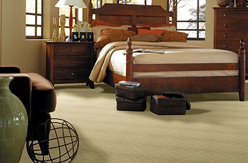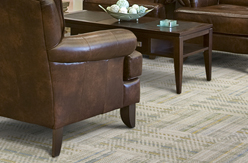Carpet – Nothing looks like it, feels like it or performs like it. It enhances the peace and quiet of your home by absorbing sound. And because carpet is a key decorative element in the home and a major purchase, you must keep several factors in mind during your selection process.
Location and Use Before purchasing carpet, you need to answer the following questions: How is the room going to be used? Will it have heavy or light traffic? Will the room be the center of activity for family and entertaining? Is there direct access from outside, or with the carpet be away from entrances? Will the carpet receive direct sunlight?
Before purchasing carpet, you need to answer the following questions: How is the room going to be used? Will it have heavy or light traffic? Will the room be the center of activity for family and entertaining? Is there direct access from outside, or with the carpet be away from entrances? Will the carpet receive direct sunlight?
Where there is to be heavy traffic (usually the family room, hallways and stairways), choose the best carpet you can afford. When shopping for carpet, look for performance rating guidelines with various brands of carpet. This rating system offers guidance on choosing the carpet that will perform best for various traffic needs. Most guidelines will be based on a 5-point scale, with the number 4 or 5 rating being best for the highest traffic areas. A 2-3 rating is good for areas with less traffic.
Color
Because it covers so much living space, carpet is the foundation of your room’s décor. It can be a neutral color, blending in with fabrics and other surfaces; or it can be a vibrant focal point of the room, making a statement that reflects your style.
The selection of carpet color is a very personal choice. Carpet comes in almost every color, pattern, and texture you can imagine. You will want to select a color that unites your decorative elements and creates the atmosphere you desire. Ever popular beige carpet make a room look spacious; but for a bolder statement, look for a common color in your furniture and draperies. Choose a carpet with a similar hue. Environmental colors, like blues, deep greens, rosy quartz, and stony neutrals are becoming increasingly popular.
Warm colors can turn up the heat in a room that lacks light, while cool greens and blues have a calming effect. Lighter colors make the room seem larger; darker color provides coziness. There are also practical considerations in color selection. New stain and soil resistant technology makes today’s lighter color carpet much easier to clean, allowing more decorating options. Medium and darker colors, tweeds, and textures will help disguise common soil in your home’s high traffic areas.
 Textures and Patterns
Textures and Patterns
Today’s carpet offers much more than a conventional loop pile. To add to a room’s sophistication and interest, consider choosing a textured pattern. New technology can produce multilevel loop, and cut/loop patterns. The texture, colors, and patter of the carpet can be made to complement or contrast with patterns of your furniture and window treatments. Using a solid color, textured carpet is a great way to provide interest and pizzazz, without going to a multicolor, overall pattern.
Fibers
Fiber is carpet’s basic ingredient. The type of fiber used and the way the carpet is constructed determine how well the carpet will stand up to spills, pets, and daily traffic. Approximately 97 percent of all carpet is produced using synthetic fibers that are designed to feature style, easy maintenance, and outstanding value. There are five basic types of carpet pile fibers: Nylon; Olefin (polypropylene); Polyester; Acrylic; Wool; and Blends.
Cost
Your budget and your needs are two key elements in selecting carpet and rugs. There are a wide range of choices and costs from which to make a selection. Ask yourself how long you expect to keep your carpet before replacing it. A better grade of carpet will give you a greater length of service than one of lesser quality. Buy the best carpet you can afford for the heavy traffic areas of your home – halls, stairs, and family rooms. A medium grade will provide good service in rooms with less traffic - bedrooms and guest rooms.